Operators are increasingly recognizing the need for a systematic assessment and management of flexible pipe integrity, but the identification of critical criteria and the means to best achieve valid and efficient inspection and monitoring (I&M) continues to evolve. Emerging technologies in I&M and operators’ expanding implementation of risk-based management are leading the way toward achieving a comprehensive integrity management approach for flexible pipeline and riser systems worldwide.
Flexible pipes are being installed and operated in more marginal and challenging offshore conditions, adding to the complexity of acquiring complete and valid data for the determination of their integrity. Especially important is the accurate assessment of the remaining life of a flexible riser so operators can avoid costly premature change outs.
To further develop the definition of best practices in flexible pipe integrity assurance, the SureFlex Joint Industry Project (JIP) presented key findings from its extensive 20-month-long survey work, including flexible pipe use worldwide, statistics on design limits, damage, and failure incidences. Conducted under the auspices of the Oil and Gas UK, a trade association for the United Kingdom upstream oil and gas industry, the “State of the Art Report on Flexible Pipe Integrity and Guidance Note on Monitoring Methods and Integrity Assurance for Unbonded Flexible Pipes (2010)” revisited the state of flexible pipe since the first survey in 2001 to 2002. The scope of work was international in its content and had the support of international companies outside of the UK.
O’Brien et al. (2011) reported the outcomes of the JIP’s data gathering from flexible pipe operators worldwide, manufacturers, and specialists in the field. From the time of the first survey, MCS Kenny compiled an in-house database of flexible pipe use, damage, and failure incidents. A comprehensive literature review was also performed. The resultant database covered 1,900 flexible risers and 1,400 static flexible flowlines; 130 production facilities worldwide; and 315 individual damage and failure incidents from around the world.
Based on the Project Database, Key Flexible Pipe Statistics are as Follows:58% of installed flexible pipes are risers. 76% of all flexible pipes have design pressures of less than 5,000 psi (345 bar). 90% of all flexible pipes are less than 10-in. in diameter. <50,000 psi-in. Pressure by internal diameter (p×ID) of the majority of flexible pipes. 70% of flexible pipe has been designed for a temperature of less than 176°F (80°C). 70% of operating flexible risers are in a water depth of less than 3,281 ft (1000 m).> |
The deepest water depth in which a flexible riser is installed is about 6,234 ft (1900 m) with a flexible pipe internal diameter (ID) of about 7.5 in. as shown in Fig. 1. Although flexible risers with ID of more than 16 in. have been installed offshore, these are in water depths not exceeding 1,312 ft (400 m). Fig. 2 shows the largest p×ID value in operation, 80,000 psi-in. for a 12-in. flexible pipe. The majority of flexible pipe in use has a p×ID value of less than 50,000 psi-in.
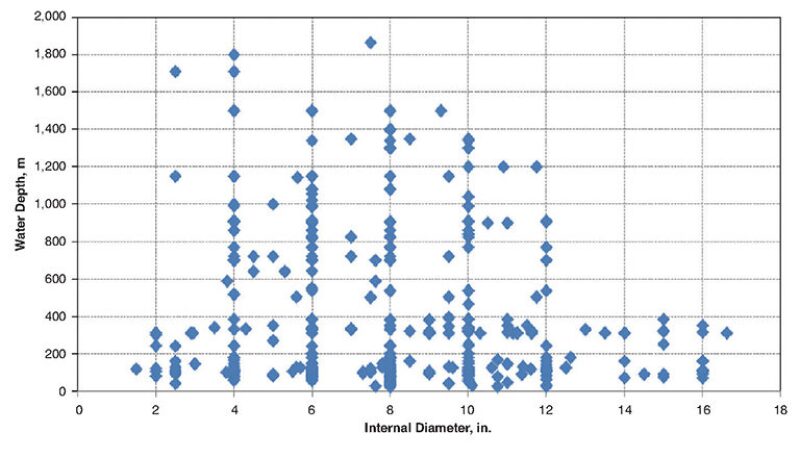
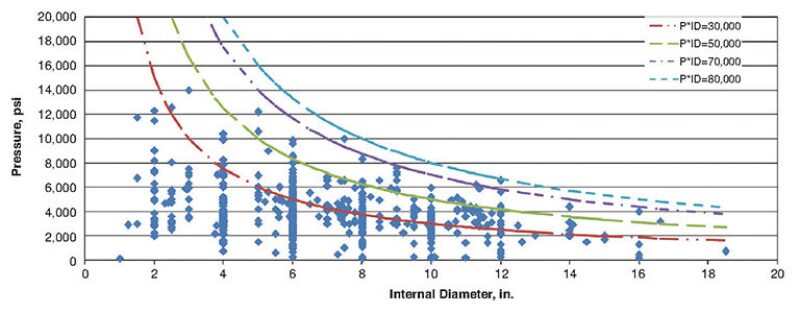
Flexible Pipe Failure/Damage Mechanisms
The most recent survey found that external sheath damage remains the most common failure, showing an increase since 2001 (Fig. 3). The external sheath is an external polymer barrier applied to the flexible pipe to resist mechanical damage and seawater corrosion of the tensile and pressure armor wires of the flexible pipe. Its presence creates an annulus between the internal barrier sheath and the external sheath of the flexible pipe.
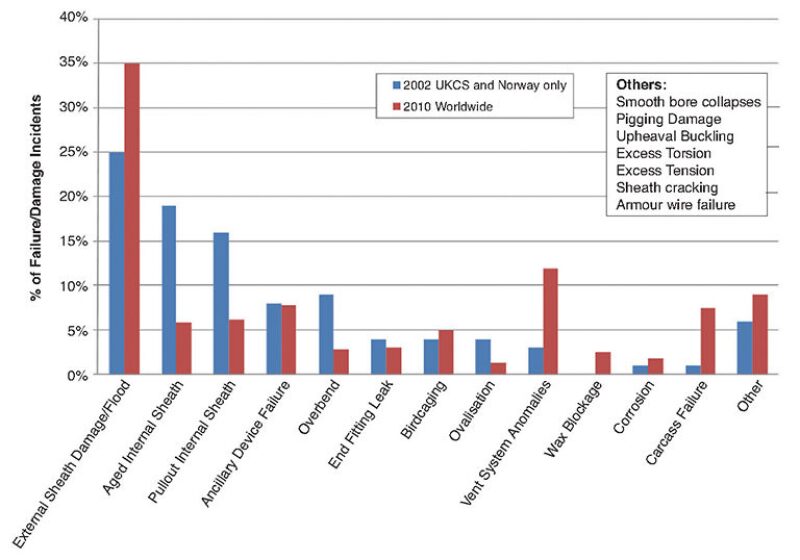
Patrick O’Brien, group director of strategic business and marketing at Wood Group Kenny, said, “We might attribute this increase to people not being fully aware of the real extent of external sheath damage in 2001, as they were likely not testing for it. However, when the issue was raised in the first report, more operators by good practice would regularly test the annuli of their flexible risers, and we began to see a higher incidence of the damage.”
In 2001, external sheath damage was identified when measurement of annulus pressure through a vent valve at the riser vessel connection revealed that the annulus did not hold its pressure, indicating that the sheath may have been breached, most likely by a small crack or a pinhole in the external sheath farther down the riser. In these cases, gross structural damage of the armor wires within the annulus was not found to have occurred.

One finding related to external sheath damage has only emerged since the original study, O’Brien said. “There is a subset of external sheath damage where general and extensive armor wire corrosion (Fig. 4) occurs due to gross external sheath damage along a region of the riser within the splash zone and where the riser may also be shielded by vessel structures. The shielding effect of the vessel structures can prevent proper operation of the riser’s corrosion protection system, while the splash zone causes intermittent wetting effects that provide a supply of oxygen, which encourages a highly corrosive environment. Hidden locations at the riser top section close to end fittings, for example at J-tubes, are susceptible to this type of external sheath breach and subsequent armor corrosion. Operators were generally not aware of its incidence or prevalence in the first study, but there have been significant instances of it in the last number of years,” he said. Operators have increased their focus on how they connect and install their flexible risers to the floating production facility so as to avoid this failure mode in the future, he added.
Two failure/damage mechanisms showing significant decreases in incidence since 2001 were related to the internal sheath—aged internal sheaths and polyvinylidene fluoride (PVDF) internal sheath pullout failures (Fig. 3). The oil and gas industry has studied the causes of aged internal sheaths, largely affected by high water content and elevated bore temperatures on polyamide 11 (PA11), a high-performance polymer material that allows for higher operating pressures than does high-density polyethylene (HDPE). As a result, operators gained a better understanding of the properties of PA11 and how to monitor, control, and predict its life cycle.
PVDF internal sheath pullout failures have dropped with the introduction of new end fitting designs developed by the flexible pipe manufacturers.
Early Planning for Integrity Management
O’Brien noted that the survey results point to the need for operators to consider their flexible pipe integrity management strategies at the earliest stages possible. “From the minute you think about designing a flexible riser or flexible pipeline, even at concept, front-end engineering design, and into operations, the guidance note recommendations propose what should be done at those stages to consider integrity,” he said.
One of the challenges in developing an early I&M strategy is the lack of coordinated efforts between project teams charged with the design and the operations personnel. “How do you get a change in behavior at the project stage? Project teams are focused on design, aiming for controlled costs. Then suddenly, it is handed over to operations,” O’Brien said.
Despite recognized issues related to flexible pipe fatigue and armor wire corrosion, and the availability of monitoring techniques such as fiber optics embedded in armor wires to allow measurement of real-life stress, operators will sometimes decide at the design stage to forego their inclusion to cut costs. O’Brien said, “They’re not thinking about the benefit that might bring to operations.
“Some operators are now making sure that they are bringing their operations people into the project team so no decision is made that might be favorable for capital expenditures, but would be a poor one for subsequent operating expenditures.”
Guidance for I&M
High-strength armor wire used in flexible pipe systems for offshore applications is subject to harsh service conditions, including service stress loadings and corrosive environments. In efforts to accurately measure the condition and remaining life of the armor wires, one of the major issues is the determination of the real conditions within the flexible pipe annulus. O’Brien said debate continues about whether or not armor wire in an annulus is fully exposed to presumed environmental conditions in the pipe bore, or if the actual environment is much more benign than what is being predicted. “Today, we assume the worst case scenario, such as if there is hydrogen sulfide and carbon dioxide in the bore of the pipe, it will permeate out into the annulus, exposing armor wires to the same conditions. However, there is significant evidence for that not being the case.”
Operators have made decisions to change out risers because their integrity prediction methods indicated that the riser was approaching its predicted fatigue life. Regarding the selection of appropriate I&M methods, O’Brien said, “Part of the problem is that there is no single magic piece of technology out there that is able to properly inspect flexible pipe. It is a bit like detective work, selecting a range of alternative inspection and monitoring techniques, which when utilized together help you to establish the current integrity of your flexible pipe.”
In a recent case, following the decommissioning of a 10-year-old flexible riser with a flooded annulus, the dissection, inspection, and laboratory analysis of components showed that the condition of the armor wire remained comparable to the as-manufactured conditions (Charlesworth et al. 2011).
Fatigue Performance of a Flooded Annulus
Charlesworth et al. described the dissection process and condition of a flexible, high-pressure gas riser following its decommissioning from the West of Shetland (WoS) region. BP managed riser integrity using a risk-based approach on its WoS flexible risers installed in the late 1990s. As part of this process, fatigue of armor wires in those risers with flooded annuli was identified as a failure mode. As occurs in many flexible risers worldwide, external sheath breaches occurred during installation of the WoS risers, causing annulus flooding. BP sealed the locations of the risers’ breaches, displaced the seawater in the annuli with a corrosion inhibitor, and implemented a program of regular fatigue life reassessments for the affected risers.
In 2008, one of BP’s WoS gas risers with a flooded annulus was identified by calculations used in the integrity management process to be approaching its predicted fatigue life, indicating that replacement was the appropriate course of action.
Following decommissioning of the riser, it was dissected at Technip’s Le Trait Manufacturing Unit and its various metallic and polymer layers were inspected. Armor wire samples were taken from the fatigue critical region of the riser and tested at Marintek to establish S-N curves in an environment representative of the affected riser’s annulus. (An S-N curve shows the results of a fatigue test as a plot of stress [S] against the number of cycles to failure [N]. A log scale is used for N.)
The major structural layers of the riser are shown in Fig. 5. Dissection locations are shown in Fig. 6, and findings of the dissection in Table 1.
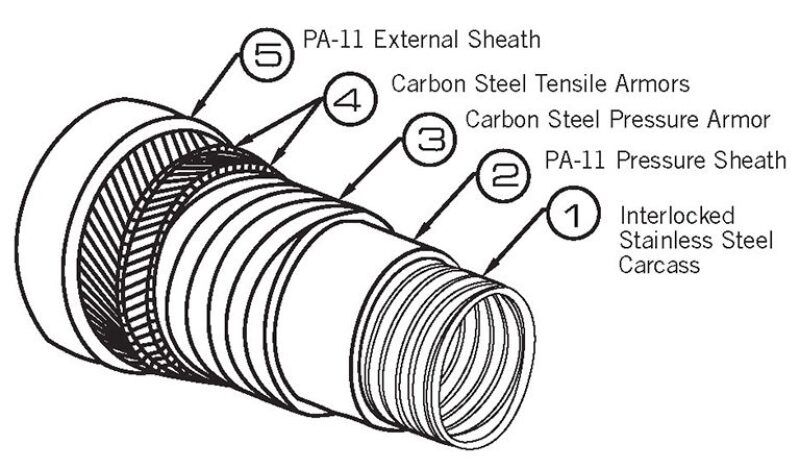

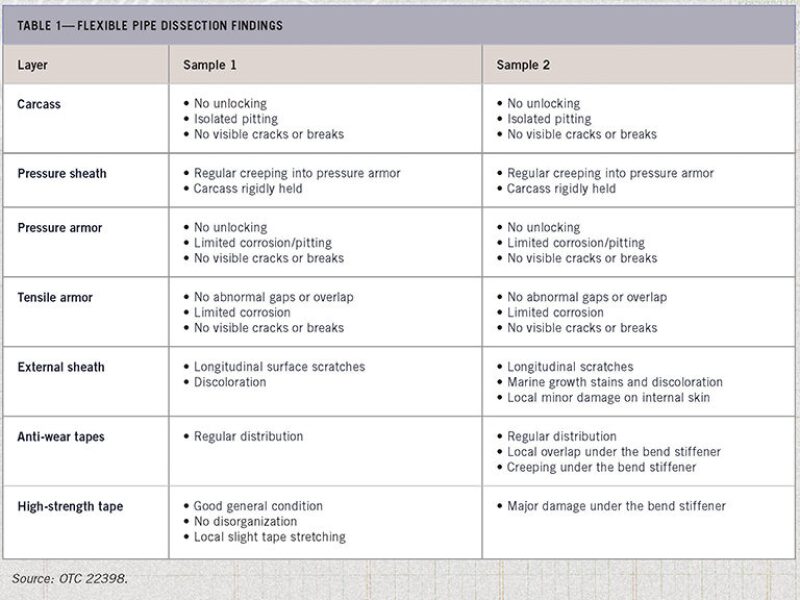
The S-N testing of the armor wire samples from the decommissioned pipe was carried out following the guidelines of a test protocol recently developed as part of a Marintek-run JIP on flexible pipe corrosion fatigue, as was the testing of the as-manufactured armor wire samples. Fatigue testing of the tensile armor wires taken from the decommissioned pipe showed fatigue lives comparable to the as-manufactured wire.
Charlesworth et al. said the findings demonstrated the conservative nature of current fatigue prediction models. As flexible pipe installations increase in more challenging environments, overly conservative fatigue prediction methodologies may limit the applicability of technology,
they added.
One factor that may contribute to overly conservative criteria used in prediction models is the lack of transparency about armor wire testing methods and results by flexible pipe manufacturers. O’Brien said that although manufacturers perform comprehensive testing and qualification of their armor wires, the results are not made publicly available. He said, “Without wanting to impact in any way or take from the commercial business of these manufacturers, as an industry, we need to get more transparency in terms of how fatigue calculations are performed, as this would facilitate the ability to radically improve our assessment of the remaining life of flexible riser systems.”
Emerging and New I&M Technologies
The magnetic anisotropy and permeability system (MAPS), an emerging technology listed in Table 2, was developed by MAPS Technology as an inspection tool that can be connected to a flexible pipe to monitor for armor wire damage and breakage.
The MAPS technology capitalizes on the magnetic properties of iron, steel, and other ferromagnetic materials and their sensitivity to stress. The internal magnetic structure of these materials is divided into domains, which are strained along the direction of their magnetization, a property known as magnetostriction. When stress occurs, the degree of domain alignment is altered, causing a measurable change in the material’s magnetic properties.
In experiments with armor wire, the wire’s magnetostriction was altered with a change in stress applied to it. The applied stress and measured stress correlated well, enabling operators to monitor the stress in armor wires, during and after a significant wave event. Field trials of MAPS were being conducted on a Petrobras platform at the time of writing of the JIP report to determine the effectiveness of the method in a real environment.
Tritech recently launched its riser and anchor chain monitoring system (RAMS), a multibeam sonar technology for floating production, storage, and offloading (FPSO) units. RAMS is deployed beneath the FPSO’s turret and extends down below the level of the bend stiffeners. The transceiver emits a horizontal sonar beam through 360° to generate and record sonar images of the spatial positions of the risers and mooring chains. RAMS has the option to provide the FPSO operator with an alarm-based system that detects out-of-specification movement of risers and mooring lines, and allows the measurement and export of trend data for use in material fatigue analysis.
The system has been installed since 2009 on the Teekay Petrojarl Foinaven FPSO, operating on BP’s deepwater oil field off the West Coast of Shetland. BP reported the system to have been 100% effective.
O’Brien said that because flexible pipe I&M techniques continue to improve and develop at a reasonably fast pace, the guidance note will be reviewed annually to keep pace with developments and to keep operators up to date.

For Further Reading
“State of the Art Report on Flexible Pipe Integrity and Guidance Note on Monitoring Methods and Integrity Assurance for Unbonded Flexible Pipes (2010)” at www.oilandgasuk.co.uk, publications, code OP010
OTC 22398 “Operational Experience of the Fatigue Performance of a Flexible Riser with a Flooded Annulus” by David Charlesworth, BP, et al.
OTC 21844 “Developments in Managing Flexible Risers and Pipelines, a Supplier’s Perspective” by C.S. Dahl, NKT Flexibles I/S, et al.
OTC 21524 “Outcomes from the SureFlex Joint Industry Project—An International Initiative on Flexible Pipe Integrity Assurance” by Patrick O’Brien, Wood Group Kenny, et al.


